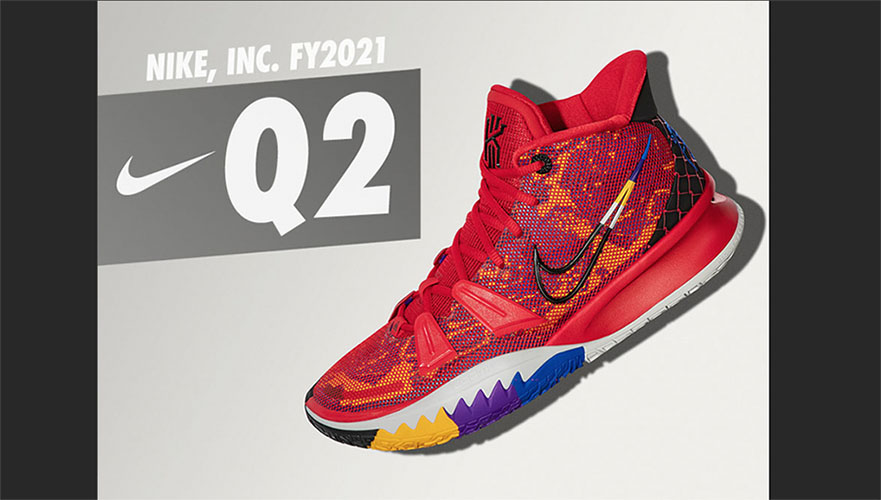Nike Inc. reported earnings rose 12.2 percent in the fiscal second quarter ended November 30 on an 8.8 percent revenue gain. Results came in well ahead of Wall Street’s estimates.
Highlights of the quarter include:
- Second-quarter reported revenues were $11.2 billion, up 9 percent compared to the prior year and up 7 percent on a currency-neutral basis driven by growth across all geographies, led by Greater China reported revenue growth of 24 percent Wall Street’s consensus estimate had been $10.55 billion
- Nike Direct sales were $4.3 billion, up 32 percent on a reported basis, and up 30 percent on a currency-neutral basis, with double-digit growth across all geographies
- Nike Brand digital sales increased 84 percent, or 80 percent on a currency-neutral basis, with triple-digit growth in North America and strong double-digit increases in EMEA, Greater China and APLA
- Diluted earnings per share for the quarter were 78 cents per share, up 11 percent. Wall Street’s consensus estimate had been 62 cents
- Inventories declined 2 percent versus the prior year and have returned to healthy levels globally
“Nike’s strong results during a dynamic environment show the power of staying on the offense,” said John Donahoe, president and CEO, Nike, Inc. “Fueled by compelling innovative product and global brand momentum, we continue to extend our leadership. Our strategy is working, and we
are excited for what’s ahead.”
The second-quarter revenue performance was impacted by strong Nike Brand digital growth of 84 percent, offset by lower revenue in our wholesale business and Nike-owned stores. During the quarter, we experienced temporary door closures in geographies affected by rising COVID-19
cases; however, more than 90 percent of its owned stores are open today, with some operating on reduced hours. We continue to experience year-over-year declines in physical retail traffic in North America, EMEA and APLA due to COVID-19 impacts and safety-related measures, partially offset
by higher conversion rates.
“With healthy inventory positions across all geographies, our return to growth is a testament to our digital strength, as well as our disciplined marketplace and financial management,” said Matt Friend, executive vice president and chief financial officer, Nike, Inc. “As we look ahead, we are focused on moving even faster against our strategic vision of Consumer Direct Acceleration and fueling sustainable, long-term growth and profitability.”
Second Quarter Income Statement Review
- Revenues for Nike, Inc. increased 9 percent to $11.2 billion compared to the prior year, up 7 percent on a currency-neutral basis.
- Revenues for the Nike Brand were $10.7 billion, an increase of 8 percent to the prior year on a currency-neutral basis driven by strong double-digit growth in Nike Direct, as well as growth in Sportswear and the Jordan Brand, slightly offset by mid-single-digit declines in its wholesale business.
- Revenues for Converse were $476 million, down 4 percent on a currency-neutral basis, as double-digit growth in digital and growth in Asia were more than offset by declines in Europe and North America primarily due to tighter supply and strategic distribution shifts.
- Gross margin decreased 90 basis points to 43.1 percent, primarily driven by higher promotional activity to reduce excess inventory resulting from COVID-19 impacts and restructuring-related costs for the previously announced reorganization, both partially offset by favorable full-price product margins.
- Selling and administrative expenses decreased 2 percent to $3.3 billion.
- Demand creation expense was $729 million, down 17 percent due primarily to lower marketing spend on brand and sports events as a result of COVID-19, slightly offset by continued investments in digital marketing to support higher digital demand.
- Operating overhead expense increased 4 percent to $2.5 billion primarily due to approximately $135 million of restructuring-related costs and continued investments in digital capabilities to support the Consumer Direct Acceleration strategy. These costs were slightly offset by disciplined expense management.
- The effective tax rate was 14.1 percent compared to 10.7 percent for the same period last year, primarily due to changes in earnings mix and an increase in tax associated with recently finalized U.S. tax regulations. This increase was offset, in part, by a more favorable impact from stock-based compensation.
- Net income was $1.3 billion, up 12 percent driven by strong revenue growth and lower selling and administrative expense, slightly offset by lower gross margin.
- Diluted earnings per share were $0.78, increasing 11 percent as weighted average common shares outstanding increased slightly.
By region, sales for Nike Brand in North America in the quarter rose 0.6 percent to $4.0 billion and gained 1 percent on a currency-neutral basis.
Sales in Greater China for Nike Brand were $2.3 billion, up 24.4 percent on a reported basis and 19 percent on a currency-neutral basis.
EMEA’s revenues for Nike Brand were up 16.6 percent to $2.96 billion and gained 12 percent on a currency-neutral basis.
APLA (Asia Pacific & Latin America) sales for Nike Brand inched up 0.2 percent to $1.47 billion and advanced 5 percent on a currency-neutral basis.
November 30, 2020 Balance Sheet Review
- Inventories for Nike, Inc. were $6.1 billion, down 2 percent compared to the prior-year period, returning to healthy levels globally.
- Cash and equivalents and short-term investments were $11.8 billion, $8.3 billion higher than last year primarily due to proceeds from a corporate bond issuance in March and positive free cash flow, partially offset by cash dividends and share repurchases. Total liquidity as of November 30th was $15.8 billion which includes cash and equivalents, short-term investments and committed credit facilities that remain undrawn.
Shareholder Returns
Nike continues a strong track record of investing to fuel growth and consistently increasing returns to shareholders, including 19 consecutive years of increasing dividend payouts. In the second quarter, the company paid dividends of $385 million to shareholders, up 12 percent from the prior year.
During its FY20 fourth quarter, Nike, Inc. temporarily suspended share repurchase activity in March to maximize liquidity during the pandemic. Prior to the temporary suspension of the share repurchase program, a total of 45.2 million shares had been repurchased for
approximately $4.0 billion, resulting in approximately $11.0 billion in remaining capacity under the 2018 share repurchase program.
Photo courtesy Nike
















